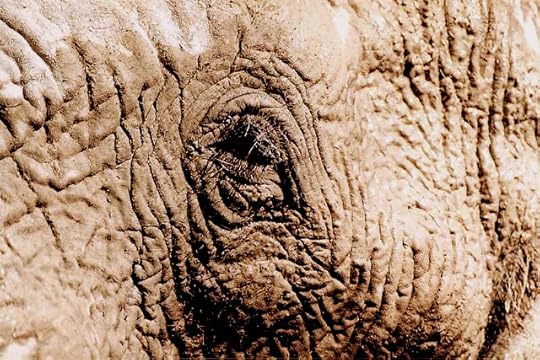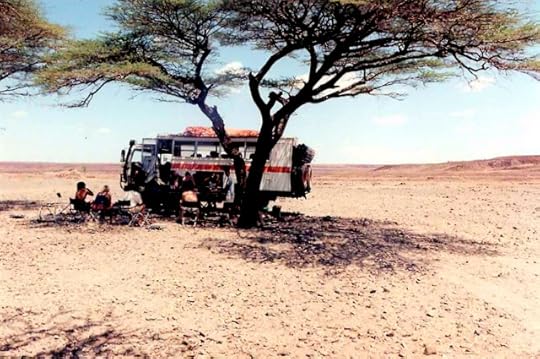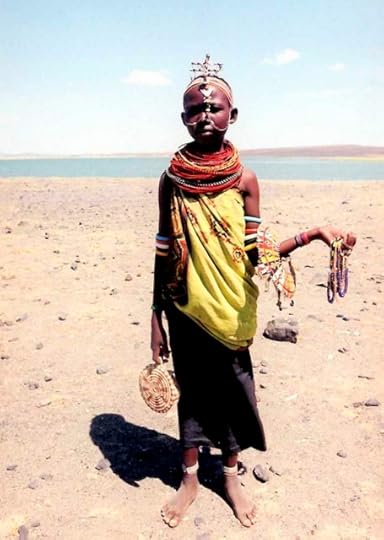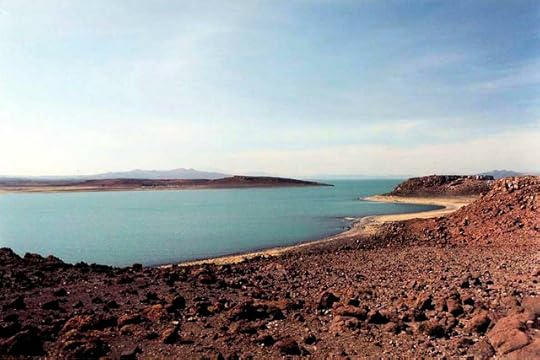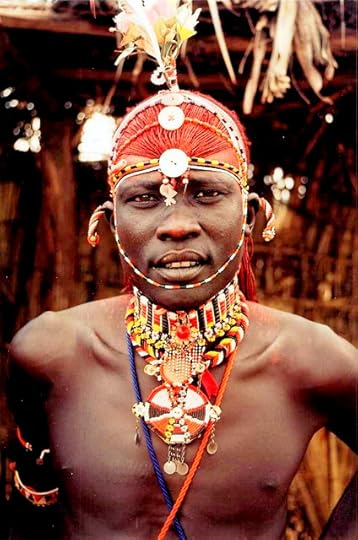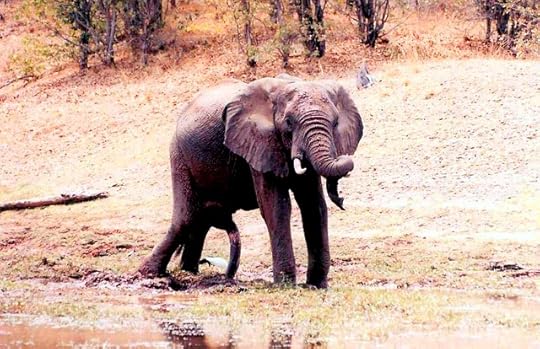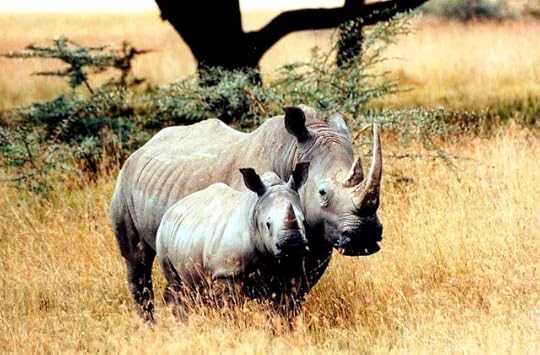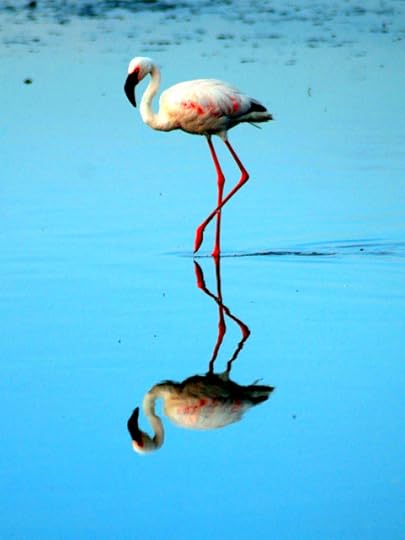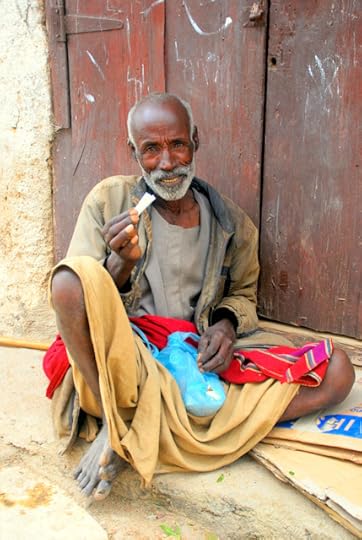Roderick Phillips's Blog, page 3
June 27, 2014
Marsabit National Park, Northern Kenya, Day 333
After a decidedly chilly night under canvas around Gof Sokorte Dika (Crater Lake) in Marsabit National Park, there is just enough time for a very brief safari before completing the long journey south back to Nairobi. And a remarkably successful safari it is too as we spot buffalo, a black colobus monkey and more elephants. Speaking of elephants, those found in Marsabit National Park are reputed to have some of the largest tusks in Kenya, if not all Africa. In fact one, who went by the name of Ahmed, had tusks weighing a combined 90 kg (200 lbs). Former president of Kenya, Jomo Kenyatta, was so enamored of this elephant that he gave the beast a presidential guard to deter poachers. And it worked! Ahmed lived to the ripe old age of 65.
No one is really that keen to move on from Marsabit. We have complete some hard travel days across some unforgiving terrain recently and the prospect of hanging out by Crater Lake is appealing. However, the Dragoman trip ends tomorrow so the truck needs to be in Nairobi. Of course the passengers can hop off the truck any time they want (Christi and I did so in Mali to visit Timbuktu), but getting back to Nairobi via public transport would be an even worse nightmare than the Dragoman truck. Reluctantly therefore we all reclaim our hot and sticky seats on the truck and off we go.
The journey is long, tedious, and for Christi and I at least unremarkable. We are so tired after the hard traveling of late that we sleep most of the way back to the Kenyan capital. And that might be the most remarkable thing about the uncomfortable ride – that we could actually sleep!
The Dragoman team kindly drop Christi and I at the Embassy hotel in central Nairobi. Our return to Nairobi is brief. Tomorrow we start a private safari to the Masai Mara. Believe it or not, it wasn’t that much more expensive to hire a private vehicle and driver / guide than join an existing tour. And having slogged around Northern Kenya for the last week with a bunch of smelly backpackers under quite challenging conditions, it wasn’t a difficult decision to return to the world of private tours and comfortable accommodation. Of course that doesn’t mean the wildlife will cooperate – you can’t buy a wildlife encounter (although I think Christi wishes you could to ensure I don’t start pouting if I don’t capture the perfect wildlife images. As if I would! Christi rolls her eyes in experienced resignation. I put it down to her lack of sleep recently).

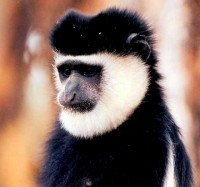

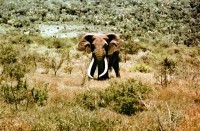
Blog post by Roderick Phillips, author of Weary Heart – a gut-wrenching tale of love and test tubes.
The post Marsabit National Park, Northern Kenya, Day 333 appeared first on Roderick Phillips.
June 26, 2014
The Chalbi Desert, Northern Kenya, Day 332
To no-ones great regret, we leave Lake Turkana this morning with plans to skirt the Chalbi desert and reach the Kenyan town of Marsabit by nightfall. Even our departure is fraught with difficulty, however, as the owners of the El Molo campsite where we stayed attempt to extort more money from the Dragoman diver / guides. It’s an unpleasant end to our stay. The dramatic volcanic scenery around Lake Turkana is undeniably spectacular, but our attempts to interact with the locals repeatedly comes down to an argument over money. Before we leave, though, we are made aware of some startling news that changes my opinion at least of Lake Turkana and the Lower Omo Valley. Briefly, the lifestyle of the indigenous peoples around Lake Turkana and the Lower Omo Valley are under serious threat as the Ethiopian government plans to build a series of dam on the Omo river to generate hydroelectric power. Much of this power will be sold by Ethiopia to neighboring Kenya, but none of the 750,000 indigenous peoples of the Lake Turkana region and Lower Omo Valley were consulted about this assault on their traditional way of life. We leave Lake Turkana sobered and somber.
Our plan is to skirt the Chalbi desert, but as I mentioned previously neither of our Dragoman drivers have attempted this route before, so the prospect of getting lost in this arid wilderness is tangible. And frankly more disturbing than running to risk of being attacked by bandits. Well Christi and I did sign up for adventure, but it’s one thing to do so in the company of experienced guides who know the terrain, and just plain crazy to trust your lives to people who have never attempted this route before! But Christi and I are meek and we jump aboard the truck and like the rest of the passengers and crew we keep our eyes open to ensure we don’t get lost – although how we would know is not discussed. I’d hate to end up a desiccated and shriveled husk found 10 years from now in a rusted out Dragoman truck by Kenyan military on maneuvers (I suppose I might be exaggerating a little here).
We don’t have a thermometer handy to measure the temperature, but the truck is so hot that you can’t rest your arm on the window sill. When the windows are open a hot harmattan-like wind blows across the Chalbi desert, stinging and burning our faces. The only living things we see are stubby thorn bushes, the occasional flat-topped acacia tree, and the odd hut where somehow the people survive by grazing goats and camels.
Remarkably there are communities even here and the first we come across is North Horr. We stop for directions. There’s little to buy – certainly no ice-cold sodas or beers and we quickly leave again. We continue bumping and jerking along. Fortunately the Dragoman truck has a large tank of water that is purified with iodine tablets. We stop frequently to fill our water bottles, pee (and with no cover its men to the front of the truck and women to rear). At one point we find a large acacia tree and stop for lunch. It’s an incongruous sight cutting tomatoes, cucumber and lettuce to put in sandwiches, while the heat relentlessly beats down upon us.
Our Dragoman trip notes talk of salt pans which we find and desert camel safaris with the Gabra people at a community called Kalacha. Remarkably we find the community (how do you figure out directions in a flat and featureless desert with no road signs?), but the formerly nomadic Gabra people now live in dismal hovels on the outskirts of the village. It’s all quite sad, but who in their right mind wants to go on a desert safari when the temperatures are so vile. Well Christi and I feel sufficiently bad that we agree to a village tour aboard these mangy beasts. I’d happily photograph the Gabra people and pay for the privilege, but they are a very reserved people. On the plus side they do not pester us for money (unlike the difficult situation at Lake Turkana), which probably means there are no rich tourists flying in to Kalacha.
The Chalbi desert is becoming monotonous, the day drags interminably, and everyone hopes that we will reach Marsabit before dark. The approach to Marsabit is unmistakable. The road begins to incline upwards and suddenly we’re on a verdant plateau surrounded by desert. Where an hour before the sun was scorching and dull desert scenery dominated our views, Marsabit is cold and green – truly an oasis in the desert. The town, however, looks grubby and furtive and exudes that frisson of danger associated with any frontier town. Our intended campsite, the Jey Jey campsite looks anything but safe and our Dragoman drivers negotiate for us to camp at the Marsabit Lodge in Marsabit National Park. It’s a stunningly spectacular drive up into the mountains and we are surrounded by rainforest: tall trees dripping with spanish moss, thick undergrowth that hides a wealth of wildlife, and then a crater lake where baboons, Marabou storks, buffalos, and elephants are frolicking. Talk about sensory overload. While setting up our tents, an elephant walks within ten feet of us. We rent a couple of rooms at the lodge and we get our first hot showers in a week. We then tuck into a feast of soup, roast beef, potatoes, green beans, and fruit salad for dessert. What a remarkable transformation in our fortunes.
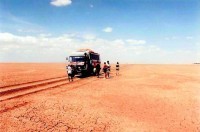
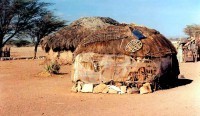
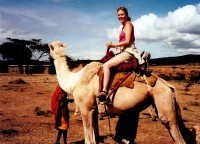
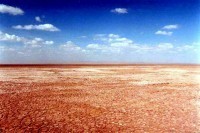
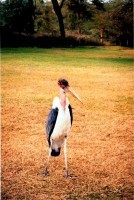
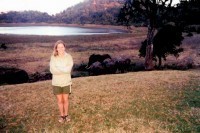
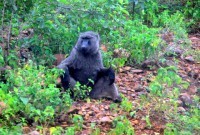
Blog post by Roderick Phillips, author of Weary Heart, a gut-wrenching tale of love and test tubes.
The post The Chalbi Desert, Northern Kenya, Day 332 appeared first on Roderick Phillips.
June 25, 2014
El Molo tribe, Lake Turkana, Day 331
The camp site in Loiyangalani is rather grim. It has few facilities, but what it does have in annoying abundance is flies. Sitting around the campsite in the morning attempting to eat breakfast is a challenge as the damn bugs seek out every orifice and an open mouth is just fly heaven. Our Dragoman driver / guides do their best to explain the plan for the day. They fully admit that neither of them have actually done this trip before so they are not sure what to expect. All they have to go on are the Dragoman trip notes, which are 5 years old! Well the plan is to visit Crocodile Island, a short boat ride away, and then a village of the El Molo people who eke out a living on the shores of Lake Turkana.
The El Molo are believed to have migrated into Northern Kenya from Ethiopia around 1000 BC. And owing to the arid environment in Northern Kenya, they were forced to abandon the agro-pastoralist activities so common in the Omo Valley area of Southern Ethiopia in favor of lakeside fishing. The El Molo are the smallest tribe in Kenya with less than 1000 members. Having said that many have inter-married with the larger Samburu and Turkana tribes and the number of ‘pure’ El Molo remaining could be less than 50. Their culture has been further eroded by the disappearance of the El Molo language. Indeed, the language may already be extinct, as most of the El Molo have adopted the language of the Samburu and Turkana people.
Crocodile Island is quite beautiful with its rugged / barren / end of the world feel. The views of the lake and the surrounding stark volcanic wasteland emphasize the remoteness of our location. The crocodiles, which are supposedly abundant hereabouts, must all be on vacation because we don’t see any.
Although we, the Dragoman passengers, enjoy the impression of solitude and isolation here at Lake Turkana, we quickly realize that the El Molo village we visit next is quite accustomed to tourists. The vast majority of the tourists arrive by air, however, and stay at the swanky Oasis Lodge. The main attraction for visitors is lake fishing, but visiting the smallest tribe in Kenya – perhaps one on the verge of extinction – is also an attractive proposition. And with money apparently no object to these rich fishermen, the El Molo have become surprisingly mercenary in their interactions with the outside world. We have to pay to enter the village; we have to pay to take photographs; and the trinkets the El Molo attempt to sell us have prices that Tiffany might ask. It is a difficult situation for everyone. Money is the focus of this visit, not cultural exchange.
Christi and I and the rest of the Dragoman passengers return disappointed to our miserable campsite where we endure oppressive temperatures. To save the day, our Dragoman drivers negotiate a deal with the owners of the Oasis Lodge to at least allow us to use their pool, which is quite wonderful.
As night descends, we walk into Loiyangalani for traditional Turkana dancing by the light of a fire. Only the fire is so minimal that we can barely see the figures shuffling unenthusiastically in the shadows.
Our visit to Lake Turkana might just be one of those cases where the journey was more exciting than the destination.
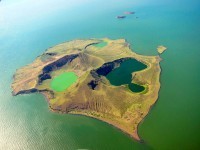
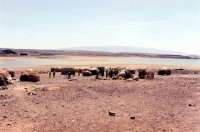

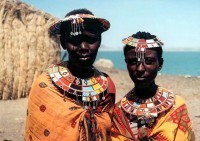
Blog post by Roderick Phillips, author of Weary Heart – a gut-wrenching tale of love and test tubes.
The post El Molo tribe, Lake Turkana, Day 331 appeared first on Roderick Phillips.
June 24, 2014
Lake Turkana, Northern Kenya, Day 330
The plan is simple today, to make it to Lake Turkana. The distance isn’t even that alarming, only 350 km, but we are told by local experts that it is over the toughest terrain possible and progress with be slow. The ride will be uncomfortable, and it will be hot – very hot. So just another average day in Africa. If and when we reach Lake Turkana tonight we will actually be closer to the Omo Valley in Ethiopia than Nairobi, so again Christi and I are searching out the remotest parts of Africa. Whereas the Omo Valley was lush and green, Lake Turkana is supposedly like the surface of the moon – barren and rocky (although much hotter).
Not surprisingly we have an early departure. We are up and about before the sun has done its stretches or brushed its teeth. Over breakfast our Dragoman driver / guide reveals some disturbing news. The road between Archers Post and Lake Turkana passes through bandit country. Typically Ethiopian and Somali fighters armed with the dreaded AK-47 assault rifles, they normally rustle cattle, but they are unlikely to pass up such an easy target as an overland truck. We don’t have a military escort so we decide to improvise. One of the passengers is black, another is wearing army fatigues; a third has the idea to duct tape the broom to make it shine like a gun barrel. Darren, the black guy and a Brit on his first trip to Africa, half volunteers / is half coerced into the Dragoman military. He sits at the front of the truck, attempting to look like a soldier while the Dragoman driver takes us north. We endure a few nervous moments, particularly when the truck gets stuck in sand and we have to unpack the sand mats. Darren is put on guard duty and his duct-taped broom looks very unconvincing.
We’re relieved to reach Maralal without incident and stop to pick up provisions for the next several days as no one knows what food might be available at Lake Turkana. The market in this small town is fairly basic and the prices go up exponentially when we try to buy fruit and vegetables. The town has a frontier feel to it, the intersection of different cultures and we see armed Turkana, Samburu, Ethiopians, Somalis to name just a few. It’s a bit like the Cantina sequence from Star Wars!
At the police checkpoint in Baragoi we are informed that there has been trouble up ahead. In the last week, four locals were killed in a cattle-rustling incident, while a World Health Organization SUV was robbed at gunpoint. This time we do get police protection – well one young, nervous police office who looks no more effective than Darren – but at least the policeman has a real gun! Fortunately we make good time because although the roads are rough, they are dry. The scenery, when one can focus on it, is starkly beautiful. We drive between the Samburu Hills to the west and Ndoto Mountains to the east.
Our police escort leaves us a few hours later at South Horr (we think he actually lives there). We also stop for a late lunch. It’s 2 pm and the lake is only 50 miles away, but we are assured that it is the worst section of the whole drive and could take 6 hours. No one wants to be traveling at night, both to avoid bandits but also because the roads are so bad. We vote and it’s close, but we agree to keep going (it’s that old adrenaline rush that all travelers get that makes us all do things we would not do in our normal lives). The closer we get to the lake, the more the truck sways from side to side as we negotiate endless deep pot holes. This is followed by a lava field of razor-sharp rocks. Progress slows to a crawl – a tortoise would sprint past us at this point as we very slowly look for the safest passage across the lava. There are some scrubby bushes and a few flat-topped acacias, but otherwise it is a desolate place and one wonders how people survive up here but they do; we even see herds of goats and camels as we approach the main ‘town’ of Loiyangalani – which has, believe it or not, an airport. Mind you flights are few and far between, but I guess most people crazy enough to visit Lake Turkana fly in!
Formerly known as Lake Rudolf (named in honor of the Crown Prince Rudolph of Austria in 1888), Lake Turkana is the world’s largest permanent desert lake and the world’s largest alkaline lake. The water is potable, but not palatable, although this does not appear to upset the healthy population of Nile crocodiles who call the lake home (but what do they eat?). And as with most other stunning natural phenomena, Lake Turkana is a UNESCO world heritage site.
As delighted as we are to be here, we’re all exhausted and we still have to set up camp at the El Molo lodge (a grand name for a section of scrub land with next to no facilities), which is a stone’s throw from the airport. There is what appears to be a mirage nearby called the Oasis Lodge. It has a wet bar and swimming pool in addition to air-conditioned rooms. This is low season and there are no guests, yet the management will not countenance a discount on the US$200 per night room rate, so we break out the tents. As it happens we are all so tired we sleep easily in this remote and barren part of Africa.

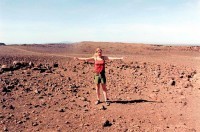
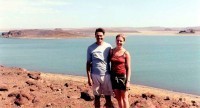
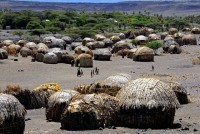
Blog post by Roderick Phillips, author of Weary Heart – a gut-wrenching tale of love and test tubes.
The post Lake Turkana, Northern Kenya, Day 330 appeared first on Roderick Phillips.
June 23, 2014
Samburu People, Northern Kenya, Day 329
We leave the Samburu National Reserve (no more wildlife safaris for a while – shame!) and drive 26 km to a Samburu village near Archers Post. At the entrance to the village the married women greet us with a traditional dance. The female passengers aboard the Dragoman truck are encouraged to join in; Christi is horrified (she hates dancing in public!), but for once shuffles her feet in a vague dancing motion as her face goes as crimson as the cloth ‘skirts’ worn by the Samburu warriors. I try not to laugh as Christi squirms for a good 10 minutes before the welcome ceremony is complete.
The Samburu are semi-nomadic pastoralists, living in Northern Kenya. They are closely related to their more famous counterparts, the Maasai who live in the Southern Kenya. The Samburu are heavily dependent on cattle (sheep, goats, and camels are also raised), since their diet is based on milk and occasionally supplemented by blood taken from the cows (who are not killed during this practice). The Samburu diet is supplemented with roots and vegetables, while meat is reserved for special occasions.
As this part of Northern Kenya is arid and rather barren, the Samburu have to move every 4-6 weeks to find good grazing areas for their cattle. To this end, huts are constructed so they can be easily dismantled and carried when the Samburu move to a new location. Their huts are built from mud, hide, and grass mats strung over poles. Typically, there is a small living area, a kitchen and two sleeping areas. The wife and the younger children sleep in one ‘bedroom’, the husband and older children in the other. A thorny fence is built around the huts for protection from wild animals. These settlements are called manyattas.
The Samburu usually live in groups of five to ten families. Traditionally men look after the cattle and protect the village from attack by other tribes or wild animals. Samburu boys learn to tend cattle from a young age and are also taught to hunt. An initiation ceremony to mark their entry into manhood is accompanied by circumcision. Samburu women are in charge of gathering roots and vegetables, tending to children, and collecting water. They are also in charge of maintaining their homes. Samburu girls generally help their mothers with their domestic chores. When a girl (as young as 12) is selected for marriage, she is also circumcised (poor thing). Officially men, but not women, can marry more than one spouse, but our guide Rebecca says that women find a way to get what they need if their spouse is otherwise engaged!
Both the Samburu men and women are elegantly dressed and the effect is enhanced with colorful beaded necklaces, earrings and bracelets and face painting. In fact it is this perceived beauty that led neighboring tribes to call them samburu, which means “butterfly”. The Samburu refer to themselves as the Loikop.
The oral history of the Samburu states that in the beginning a woman died leaving behind two sons. The boys split everything equally until it came to the contents of the house. One boy took beads and became the Maasai, the other took a leather bag and became the Samburu. To this day when a Samburu man takes a wife, the girl leaves home with a leather bag full of possessions – and nothing else.
Before we leave the young Samburu warriors show off their skills, such as making fire with sticks and donkey dung, and dancing. The higher the warrior jumps during the dance the more desirable he is.
We camp away from the village, along the banks of the Ewaso Ngiro river. The headman fears for our safety, however. Wild animals – especially crocodiles – bandits, and needy Samburu women are all a threat apparently! He stations some of his warriors around our campsite (for a non-negotiable fee) although whether gun and spear-toting warriors equals safety or not I don’t know. Let’s just say when the urge to pee strikes in the middle of the night, I cross my legs and try not to listen to the sound of the nearby river!
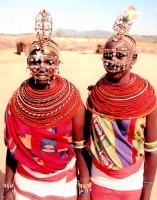
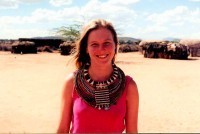
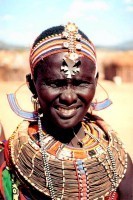
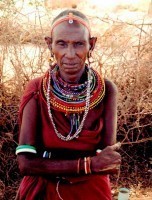
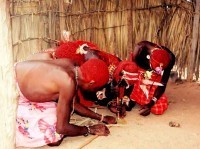
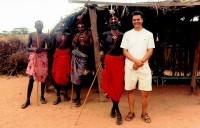
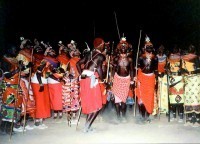
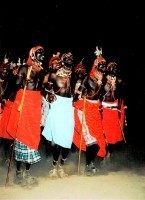
Blog post by Roderick Phillips, author of Weary Heart – a gut-wrenching tale of love and test tubes.
The post Samburu People, Northern Kenya, Day 329 appeared first on Roderick Phillips.
June 22, 2014
Game Drive, Samburu National Reserve, Day 328
The Samburu Lodge organizes a contrived evening feeding session (a bit like the hyena feeding in Harar) to bring in leopards so that visitors can gape and awe at these magnificent creatures. The Dragoman crew were aware of this, but while we waited patiently at the lodge last night with our expensive sundowners, the action was actually across the Ewaso Ngiro river. The leopard is so well trained that it turns up now whether food is set out or not. The local guides know this and take the punters to the source of the action – not the source of the booze. To compensate for last night’s fiasco, our Dragoman crew insist upon starting the game drive early. Many of the passengers partied hard last night so only a handful of us brave the cold morning to go wildlife viewing.
The difference between a game drive in small vehicles with expert guides and a Dragoman driver in an unwieldy ten ton truck is stark. Navigating the tight dusty tracks in Nora is difficult and every creature in Africa must hear our vehicle coming. This is not ideal when you are hoping to approach skittish big cats as quietly as possible. Our big cat encounters are therefore non-existent. Having said that Samburu National Reserve is home to elephants, a variety of antelope and some very rare animals, including Grevy’s zebra and the reticulated giraffe. Compared with other zebras, Grevy’s zebra is taller, has larger ears, and its stripes are narrower. Also the Grevy’s zebra does not live in harems. It’s population has declined to less than 3,000 and is considered endangered.
Funnily enough, although the range of the reticulated giraffe is limited to Northern Kenya, Southern Ethiopia and Somalia (and good luck spotting wildlife in Somalia), the reticulated giraffe is common in zoos around the world. Still it is cool to spot these fellas in the wild. And here’s a fast fact about giraffes. They are the tallest land mammal. The reason for this can be attributed to a ritual known as “necking”, where two males fight for reproduction rights by slamming their necks into one another. The giraffes with the tallest and strongest necks are victorious and get to mate with the females, thus passing these genes on to future generations. So now you know.
By the way, ever seen the ‘giraffe-necked’ antelope – otherwise known as a gerenuk (which in the Somali language means ‘giraffe-necked)? As the name implies they are characterized by their long slender necks and legs, which enables them to stand on their hind quarters and stretch high into bushes and acacia trees to eat leaves that are out of reach to smaller antelopes such as impalas and gazelles. The down side to their slender physique is that they are prone to breaking leg bones, making them an easy snack for big cats.
And that’s the end of the game drive. We’re going to change gears for the rest of this brief Dragoman trip and focus on cultural safaris from now on. We begin with the Samburu. Well we will tomorrow. Ta-ta for now.

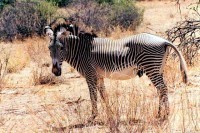


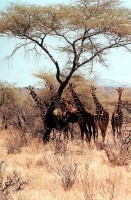
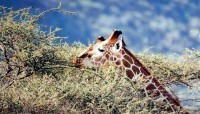
Blog post by Roderick Phillips, author of Weary Heart – a gut-wrenching tale of love and test tubes.
The post Game Drive, Samburu National Reserve, Day 328 appeared first on Roderick Phillips.
June 21, 2014
Frisky elephants, Northern Kenya, Day 327
Christi and I together with the other dozen or so passengers on this Dragoman trip leave the town of Nakuru early and in a confusing alliterative sequence drive through Nyahururu, Nyeri, and Nanyuki on our way to the Samburu National Reserve. The reserve is famous for elephants, big cats and some species rarely found outside of this area. Mostly, though, this is a long driving day and although the roads are rough, we are taking the most comfortable, if not the shortest, route to the land of the Samburu. To break up the monotony of the journey, we stop along the way for a couple of activities. The first is a fairly impressive waterfall, the other is crossing the equator. Over the last 10 months crossing the equator has become something of a regular occurrence for Christi and I, beginning in Ecuador, then the Galapagos Islands, and for the last time in Brazil. This will be the first time we have crossed the equator overland in Africa, though.
Thomson’s Falls is a 74 m (243 ft) scenic waterfall on the Ewaso Ngiro river, which drains from the Aberdare Mountain Range (an 11,000 ft, 160 km long mountain range in central Kenya located just south of the equator). The falls are situated two miles from Nyahururu. In 1883 Joseph Thomson, the Scottish geologist and naturalist, was the first European to reach the falls and apparently that was enough of an achievement to have the falls named in his honor. They do make for a nice photo stop, though.
Further down the road near Nanyuki we cross the equator (back into the northern hemisphere). A dilapidated sign marks the spot (latitude zero degrees). And here are a couple of fast facts for you: the equator is 40,075 km (24,901 mi) long and only about 20% is over land. An enterprising chap with a funnel, a bowl of water, and a few sticks is available – for a fee – to demonstrate the Coriolis Effect. Christi and I experienced this phenomenon previously, right at the beginning of our Year of Wonder in Ecuador. In essence, water drains clockwise in the northern hemisphere and counterclockwise in the southern hemisphere. And it did so today as well so all is right with the world (at least in the northern hemisphere).
Late in the day we finally arrive in Samburu National Reserve. We drive to our campsite beside Ewaso Ngiro river, which not only feeds Thomson’s Falls but also an abundance of wildlife within the reserve. We begin, though, with the more mundane elephants and Nile crocodiles who appear to have little interest in one another. On the other hand the elephants do appear quite interested in each other. I’m not sure there is such a thing as elephant porn, but let’s just say some of these guys are clearly exhibitionists. Which is more than can be said for Christi and I after this long, hot, rough drive. All we crave is a hot shower and a good night’s sleep.
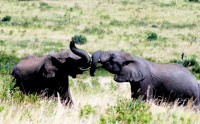
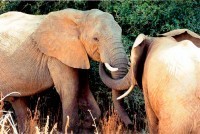

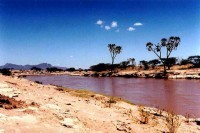
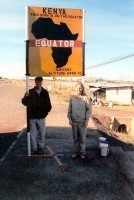
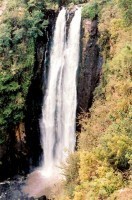
Blog post by Roderick Phillips, author of Weary Heart – a gut-wrenching tale of love and test tubes
The post Frisky elephants, Northern Kenya, Day 327 appeared first on Roderick Phillips.
June 20, 2014
Rhino encounters, Lake Nakuru, Day 326
Considering Christi and I are back under canvas, we sleep remarkably well – if not long enough. I may have mentioned this before but we are not natural campers. Indeed, outside of Africa we have never camped together and since we have been dating for 11 years I think it’s a safe bet that when we return to San Francisco any vague thoughts we have of car camping in Yosemite National Park will quickly fall away in favor of five-star treatment at the Ahwahnee hotel. Anyway I’m digressing back to fantasy land. We’re up at 5.50 am. It’s cold but clear and someone has boiled the kettle and prepared breakfast – god love ‘em. It’s 6.45 am when we begin the game drive and although one can never know what wildlife will wander in front of my eager lens, Lake Nakuru is one of the few places in Africa where you stand a good chance of spotting both black rhino and white rhino.
Lake Nakuru is just beautiful this morning: acre upon acre of yellow fever trees, tall wavy savannah grass which I know is hiding a multitude of wildlife, including – ones hopes – the rhino. There’s also the impressively sheer escarpment towering over the plains, and of course, the soda lake itself - home to thousands if not millions of flamingos. We steer away from the lake this morning and focus on the favorite habitat of the rhino, just in case one of the buggers choses to show himself. You’d think it would be hard to hide an animal that weighs a ton or more, but boy is it hard work to spot these blighters. We do see plenty of buffalo, an eland (large antelope), an eviscerated zebra (ouch!), some waterbuck, and we chase some impala down a dusty track. They are none too bright these guys because instead of running into the savannah they must have run down the track for half a mile before one of them thought to hook a left!
Finally, rhinos – yippee! I barge the other passengers out of the way in my haste to photograph these titans of the African Plains.
Here are some fast facts to separate the black and white rhino should you come across one while out wandering the African savannah.
Black Rhino (Hooked-lip Rhino)
Smaller than the white rhino. A large bull weighs around 1000 kg/2,200 lbs.
They have a rather small hooked shaped mouth for feeding on trees and shrubs.
The black rhinos’ natural head posture is face upward, so there is no need for it to lift its’ head when feeding off trees.
Black rhino are often found in thick vegetation which is possibly the reason why the female will often run in front of her calf to clear a pathway.
The black rhino is short-tempered and extremely aggressive.
They are very solitary and seldom join up with other individuals.
White Rhino (Broad-mouthed Rhino)
Larger than black rhino. Large bulls reaching weights of 2500 kg./5,500 lbs.
They have a very broad flat mouth which aids in feeding off large quantities of grass.
A white rhinos’ natural head posture faces downward as its’ mouth is always close to the ground while grazing.
They have a very distinct hump above the shoulders as well as a very prominent fold of skin at the lower parts of the shoulders.
Being a very social animals it is not uncommon to see 10 or 15 white rhinos moving together and sometime more.
White rhino are normally found in very open areas such as plains.
The calf normally runs in front of its mother, with the mother using her horn to direct the calf by tapping it on the rear.
(reference: http://southafrican-wildlife.blogspot.com/2008/10/difference-between-black-and-white.html)
Blog post by Roderick Phillips, author of Weary Heart – a gut-wrenching tale of love and test tubes.
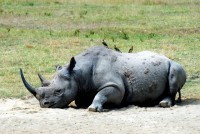
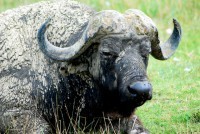
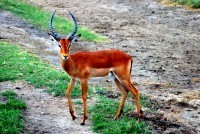
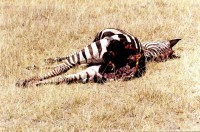
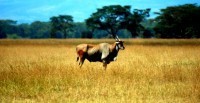
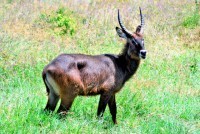
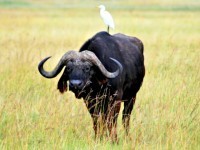
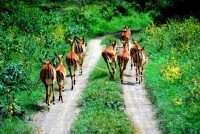
The post Rhino encounters, Lake Nakuru, Day 326 appeared first on Roderick Phillips.
June 19, 2014
Lake Nakuru National Park, Kenya, Day 325
This is an odd Dragoman adventure because Christi and I are joining part way through and will leave before the truck reaches its final destination. Once again when I was planning this in San Francisco and looking at ways to explore the remote north of Kenya, Dragoman was the only reliable overland company that ventured up that way. There was no guarantee of course that there would be space available or that our itineraries would mesh, but somehow they did. Because this is not the start or finish of a section, there is no formal joining meeting. Instead Christi and I search out the drivers at the Boulevard hotel in Nairobi, pay both our joining fee and kitty and then its all aboard the Dragoman express (see here for more details on joining a Dragoman tour). Next stop Lake Nakuru National Park. In truth we could have combined a visit to Lake Nakuru with a visit to the Masai Mara National Reserve, but as Dragoman are going to Nakuru anyway, there seems little point in paying twice.
Our Dragoman truck goes by the decidedly unrugged name of Nora. It takes almost 3-hours of spluttering and coughing before we reach Lake Nakuru National Park, which lies in Central Kenya, 140 km north-west of Nairobi. The park mainly comprises the soda lake itself, although over the years more land has been set aside including savannah grasslands around the lake and an escarpment overlooking the lake. The park supports a wide ecological diversity, especially the Greater and Lesser flamingos. Indeed, the lake is a world famous habitat for Greater flamingos (bill has a black tip; less common) and Lesser flamingo (deep red carmine bill and pink plumage; more common). And these guys come in the hundreds of thousands. It has been estimated that as many as two million flamingos call the lake home. They feed on the abundant algae, which thrives in the warm waters.
After looking at the lake and flamingos close up we drive up to the top of the escarpment and view the lake from Baboon Cliff, before continuing on to Makalia North campsite. As we’re putting up the tents and the guys on cooking duty prepare dinner it starts to rain. Just great. The toilet block also leaves a lot to be desired and while there are showers, the water is absolutely freezing. All in all, it’s a cold, damp night and the last thing thing I want to be doing is sleeping under canvas. Torrid images of the Hilton hotel in Addis Ababa fill my night-time dreams: rolling around in a king-sized bed amid clean white sheets, luxuriating in a steaming hot bath, and fine dining in a fancy restaurant. It’s a shame the reality does not match my raunchy dreams, although apparently lions were seen on the periphery of the camp site during the night. Missed that.
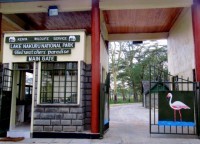

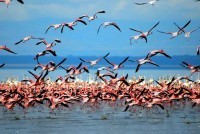

Blog post by Roderick Phillips, author of Weary Heart – a gut-wrenching tale of love and test tubes.
The post Lake Nakuru National Park, Kenya, Day 325 appeared first on Roderick Phillips.
June 18, 2014
Market day, Harar, Day 324
This is our last day in Harar and in Ethiopia generally. Once again this country has given Christi and I the most magnificent experiences. It is definitely the unheralded destination on the African continent. Morocco, Egypt, Kenya, Tanzania, and South Africa get the bulk of tourists, but Ethiopia is right up there for tourist attractions and well worth considering when you are planning your next African vacation. It is market day in Harar and we have only a little time to explore before we leave. We also take a final wander around the famous walled city. The staff at our hotel have been very nice, but water and power have been irregular. And when the management learned that Christi was an American, they suggested she pretend to be Canadian while in Harar. Apparently, we are just close enough to the Horn of Africa and the Arabian Peninsula that some anti-American sentiment has crept in.
Chat aside, market day is a fairly typical affair. It’s mostly fruit and vegetables, although there are a few baked treats such as donuts. And as usual the women are very good at carrying produce on their heads. We enter the walled city of Harar (known as Jugol) through the Shoa gate and follow the narrow streets and alleyways to no real purpose. It’s all about soaking up the atmosphere and securing those last memories of our time here in wonderful Ethiopia.
All too soon it’s time to be pragmatic again. We have decided not to return to Addis Ababa by Sky Bus – the outward journey was just a little too exciting for us, especially now that we know the drivers like to chew chat. Instead we will fly back to the Ethiopian capital (and one can only hope that pilots are held to a higher standard of sobriety than their colleagues in charge of terrestrial transportation). It is a reassuringly dull 1-hour flight aboard Ethiopian Airlines from the nearby regional capital of Dire Dawa rather than an 8.5-10 hour bus ride. We then check-in for our international departure. This time we are flying Kenyan Airlines. Now we could have embraced the 3-day bus ride from Addis to Nairobi, which (although authentic) would be very long, very uncomfortable, and involve travel through Bandit country (Northern Kenya is actually pretty remote – it being an arid extension of the Lower Omo valley). But before you call Christi and I wimps, we have arranged a tour of Northern Kenya starting from Nairobi…tomorrow. Okay, now that part wasn’t very well thought out, but we’ll be overlanding again with Dragoman (I know I can’t believe it either, but they are cheap) for just a few days (not their whole trip).
It is only 2-hours by plane from Addis Ababa’s Bole Airport to Nairobi’s Jomo Kenyatta International Airport, but everything changes for Christi and I. No longer are people curious to talk to us and find out more about our respective countries. In Nairobi (Nairobbery as it is known among backpackers), we are a commodity – a source of dollars, pounds, and euros, and everyone wants their share. This begins at the airport after we have cleared customs and immigration. The driver of the taxi service we use to get into town insists that our chosen hotel, the Terminal, is full and we should go the Embassy hotel instead. He also claims the Embassy is a much nicer hotel. We will not be swayed, though, and reluctantly he takes us to the Terminal, which it transpires has plenty of space. Even during the brief walk from the taxi to the hotel, we are grabbed by touts eager to sell us safari trips. This is the difference between an undeveloped tourist destination like Ethiopia and one that is used to a lot of tourists. Thank goodness we will only be in Nairobi one night.




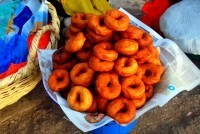
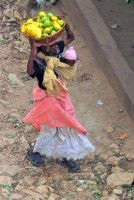
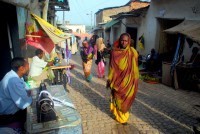
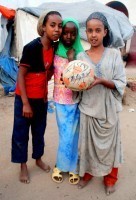
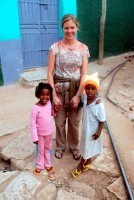
Blog post by Roderick Phillips, author of Weary Heart – a gut-wrenching tale of love and test tubes.
The post Market day, Harar, Day 324 appeared first on Roderick Phillips.

